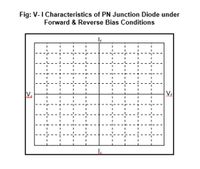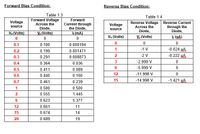
Introductory Circuit Analysis (13th Edition)
13th Edition
ISBN: 9780133923605
Author: Robert L. Boylestad
Publisher: PEARSON
expand_more
expand_more
format_list_bulleted
Question
- Take a graph sheet and divide it into 4 equal parts. Mark origin at the center of the graph sheet.
- Now mark +ve X-axis as Vf, -ve X-axis as Vr, +ve Y-axis as Ifand –ve Y-axis as Ir.
- Mark the readings tabulated for Si forward biased condition in first Quadrant and Si reverse biased condition in third Quadrant.

Transcribed Image Text:Fig: V-I Characteristics of PN Junction Diode under
Forward & Reverse Bias Conditions
V.
Ve

Transcribed Image Text:Forward Bias Condition:
Reverse Bias Condition:
Table 1.3
Forward Voltage
Across the
Diode,
Vr (Volts)
Table 1.4
Forward
Reverse Voltage Reverse Current
Across the
Diode,
Voltage
Current through
the Diode,
Voltage
through the
Diode,
source
source
Ve (Volts)
(mA)
Va (Volts)
Ve (Volts)
k (YA)
0.1
0.100
0.000194
-0.024 yA
-0.222 uA
0.2
0.199
0.001471
1
-1 V
2
-2 V
0.3
0.291
0.008873
-2.999 V
0.4
0.364
0.036
6.
-5.999 V
0.5
0.411
0.089
12
-11.998 V
0.6
0.440
0.160
0.7
0.461
0.239
15
-14.998 V
-1.421 UA
1
0.500
0.500
2
0.555
1.445
6
0.623
5.377
12
0.661
11
15
0.674
14
20
0.689
19
Expert Solution
This question has been solved!
Explore an expertly crafted, step-by-step solution for a thorough understanding of key concepts.
Step by stepSolved in 2 steps with 2 images

Knowledge Booster
Learn more about
Need a deep-dive on the concept behind this application? Look no further. Learn more about this topic, electrical-engineering and related others by exploring similar questions and additional content below.Similar questions
- The reflection coefficient for a device is found to be 0.75. What will be the corresponding return loss of the device?arrow_forwardQ8 - You wish to end up with a 2um width metal line (measured at the top of the metal lead cross section). A) You are using an isotropic wet etch process on a 1um thick metal layer. What linewidth should the protective photoresist line be to get these results? Sketch the resulting structure before photoresist strip. B) now you are using a completely anisotropic etch, what is the requisite linewidth of the photoresist to achieve the same end goal? Sketch the resulting structure before the stripping of the photoresist.arrow_forwardTwo positive point charges q1=4.40 uC and q2=6.40 uC are separated in vaccum in distacne of 6.0m find the magnitude of the net electric at point r!=4.80m from q1 in N/Carrow_forward
Recommended textbooks for you
 Introductory Circuit Analysis (13th Edition)Electrical EngineeringISBN:9780133923605Author:Robert L. BoylestadPublisher:PEARSON
Introductory Circuit Analysis (13th Edition)Electrical EngineeringISBN:9780133923605Author:Robert L. BoylestadPublisher:PEARSON Delmar's Standard Textbook Of ElectricityElectrical EngineeringISBN:9781337900348Author:Stephen L. HermanPublisher:Cengage Learning
Delmar's Standard Textbook Of ElectricityElectrical EngineeringISBN:9781337900348Author:Stephen L. HermanPublisher:Cengage Learning Programmable Logic ControllersElectrical EngineeringISBN:9780073373843Author:Frank D. PetruzellaPublisher:McGraw-Hill Education
Programmable Logic ControllersElectrical EngineeringISBN:9780073373843Author:Frank D. PetruzellaPublisher:McGraw-Hill Education Fundamentals of Electric CircuitsElectrical EngineeringISBN:9780078028229Author:Charles K Alexander, Matthew SadikuPublisher:McGraw-Hill Education
Fundamentals of Electric CircuitsElectrical EngineeringISBN:9780078028229Author:Charles K Alexander, Matthew SadikuPublisher:McGraw-Hill Education Electric Circuits. (11th Edition)Electrical EngineeringISBN:9780134746968Author:James W. Nilsson, Susan RiedelPublisher:PEARSON
Electric Circuits. (11th Edition)Electrical EngineeringISBN:9780134746968Author:James W. Nilsson, Susan RiedelPublisher:PEARSON Engineering ElectromagneticsElectrical EngineeringISBN:9780078028151Author:Hayt, William H. (william Hart), Jr, BUCK, John A.Publisher:Mcgraw-hill Education,
Engineering ElectromagneticsElectrical EngineeringISBN:9780078028151Author:Hayt, William H. (william Hart), Jr, BUCK, John A.Publisher:Mcgraw-hill Education,

Introductory Circuit Analysis (13th Edition)
Electrical Engineering
ISBN:9780133923605
Author:Robert L. Boylestad
Publisher:PEARSON

Delmar's Standard Textbook Of Electricity
Electrical Engineering
ISBN:9781337900348
Author:Stephen L. Herman
Publisher:Cengage Learning

Programmable Logic Controllers
Electrical Engineering
ISBN:9780073373843
Author:Frank D. Petruzella
Publisher:McGraw-Hill Education

Fundamentals of Electric Circuits
Electrical Engineering
ISBN:9780078028229
Author:Charles K Alexander, Matthew Sadiku
Publisher:McGraw-Hill Education

Electric Circuits. (11th Edition)
Electrical Engineering
ISBN:9780134746968
Author:James W. Nilsson, Susan Riedel
Publisher:PEARSON

Engineering Electromagnetics
Electrical Engineering
ISBN:9780078028151
Author:Hayt, William H. (william Hart), Jr, BUCK, John A.
Publisher:Mcgraw-hill Education,